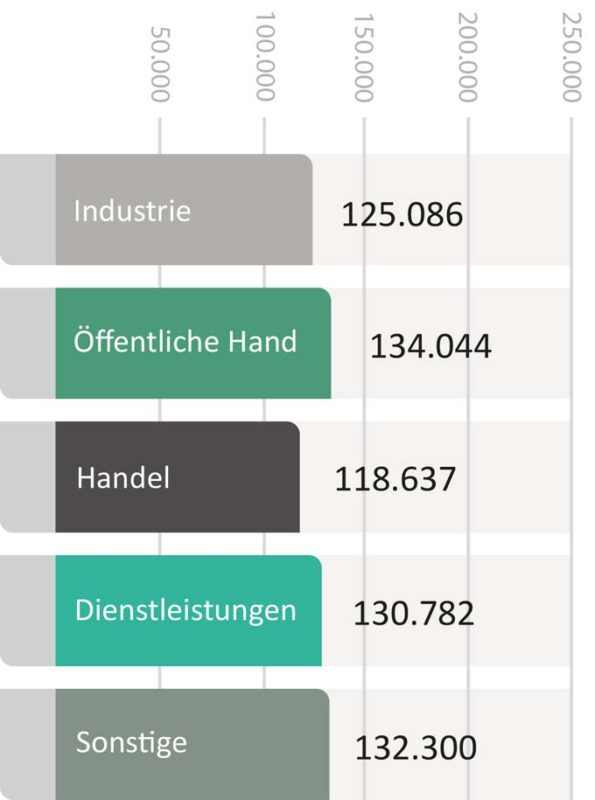Is the home office hype finally over?
The FH Wage Study 2025 provides insights into part-time and full-time work, the popularity of company benefits and working from home. The results show: Working from home is still popular. However, the offer is often not fully utilized. However, one fact is particularly surprising.

11,906 people took part in the survey for the FH Salary Study 2025 in the first quarter and provided extensive information on their salary situation. We have already reported on this. The participants in the study all graduated from a Swiss university of applied sciences. They work in almost all sectors, most of them are 40 years old or younger (67% of all respondents) and around half of them work in a management position, just under a third in middle or upper management positions.
The participants also answered some additional questions on four topics:
- Flexible working or home office
- Offers from employers (benefits)
- Part-time or full-time work
- Independence
The majority do not work from home
On the subject of working from home, respondents were asked how much they actually work from home, how much working from home their employer would allow and how much they would like to work from home.
Surprising at first glance: at a good 34%, the largest group is those who never work from home at all. In many cases, there is probably no opportunity to do so (for private reasons or due to the job, e.g. in healthcare professions). However, it is also clear that at least some of the respondents voluntarily choose not to work from home. The proportion of those for whom employers do not offer the option of working from home is only 19%.
Among the 80% who are allowed to work from home, the most popular option is one day working from home (18% response rate), followed by half a day (16%). With two days working from home, the figure is only 10%, although this 40% home office share would be the option most frequently offered by companies. What is striking and surprising in the study is that 8% of respondents are allowed to work completely remotely and never have to physically attend work. This is used by just 1% of respondents. Only 3% report the need (desire) to do so. This shows that The demand for "total home office" is very small and, above all, significantly smaller than the supply.
The bottom line is this: Where home office is permitted, it is usually up to 40% or two working days. One working day is the most popular - this is also where the offer, desire and reality come together best - see the following graphic.

Offers and benefits
Only around one in twenty (5%) of all respondents were unaware of any form of offer from the company. Support with meals in various forms is widespread (53%), as are offers for further training (55%). Benefits in the area of insurance, on the other hand, are rare: Only just over one in ten (12%) receive such offers, although the demand would certainly be there, with one fifth (22%) welcoming a contribution from the company. More than a quarter (27.%) can take time out and sabbaticals. 41% receive support in the area of transportation, for example public transport season tickets, and a further 25% would like this. Interestingly, the proportion of employees who neither receive nor would like to receive offers is relatively high. In the area of insurance (67%) this is two thirds, in the areas of physical and mental health as well as time off and sabbaticals half each, and slightly more for mobile/Internet (53%). Only flexible working hours are important and desirable for the vast majority.
Part-time versus full-time
Gut zwei Drittel arbeiten Vollzeit (67.5%). Dabei spielen finanzielle Überlegungen die grösste Rolle, dies gaben 64%der Teilnehmenden an. Mehr als die Hälfte (55%) arbeitet Vollzeit, weil ihnen die Arbeit gefällt. Weiter gibt etwas mehr als ein Drittel (36%) an, dies aus Karrieregründen zu tun. Eher selten wird Vollzeit gearbeitet, weil die Arbeitgeberin dies so wünscht – gut 13% gaben dies an.
The other almost third (32.5%) work part-time - often due to their life situation. This is often due to family obligations, i.e. caring for family members alongside work (children or parents). More than a third state this (36%). The most common personal preference of respondents is to work part-time. 40% do not want to work more than they do now. Other reasons for working part-time are relatively rare. The vast majority of "part-timers" are satisfied with their level of employment: almost 66% would like to continue working the same amount. It is also interesting to note that significantly more part-time employees would rather reduce their workload further than increase it.
Self-employment: men are attracted by the financial side, women by the work-life balance
The topic of self-employment has already preoccupied many working people, some of whom already have experience of it. The questions on this topic dealt with reasons for or against self-employment - as well as factors that effectively tipped the scales in favor of or against self-employment. The comparison between men and women is interesting here. Men most frequently cited financial incentives and the opportunity to make better use of their own skills as reasons for self-employment (62% and 61% yes answers). Women, on the other hand, most frequently cited private reasons or a better work-life balance, which they sought as a result (56% yes). Other reasons given were "Attractive business idea" and "Social reasons" (e.g. founding team).
The gender gap is also evident when it comes to the reasons for giving up self-employment. For men, the most common answer is clearly that an attractive job was tempting. For women, social reasons were again the most frequently cited (e.g. teamwork).
Source: FH Switzerland









